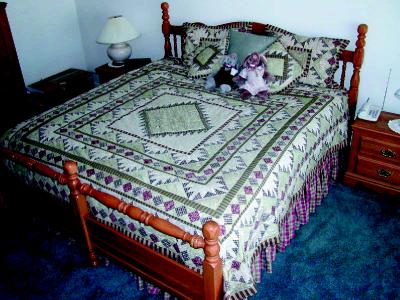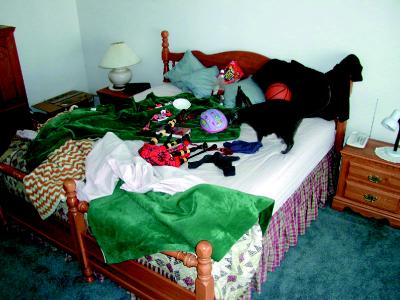The medical specialty of public health deals with making recommendations and creating legislation that benefit entire populations. This discipline has a proud record of major achievements, such as ensuring safe drinking water, childhood immunizations and seat-belt laws. Several major challenges still lie ahead. Although lawn darts have been rightfully banned, other injurious substances remain readily available, including tobacco, Big Macs and country music.
One little appreciated public health danger lurks in the nation's bedrooms; more specifically, in the nation's beds. We wish to draw attention to the hazardous habit of bed-making, pandemic in North America. Not only is this recently evolved practice unhygienic, the mechanics of straightening the corners and fluffing the pillows is physically injurious and adversely affects the mental well-being of our population.
Beds have been around since Adam and Eve hurriedly trampled a flat spot in the grass of the Garden of Eden. Studies of Paleolithic man have uncovered many bed sites, none of which has ironed fur and perfectly tucked corners. Unmade beds are therefore thought to select for survival. We speculate that Neanderthals who devoted time and energy to bedding maintenance while their neighbours were out foraging were more likely to have suffered from caloric insufficiency. In addition, primeval bed-makers may have succumbed to predation more frequently because it was probably a serious mistake to turn one's back on an unlocked cave door. The inevitable conclusions are that, after millions of years of evolution, our bodies have become accustomed to an unmade bed and that the modernization of the sleeping arena to a contrived geometric precision is yet another example of current societal maladaptation.
A brief review of physiology reveals the sound science behind the rumpled sheets. The average Canadian consumes 3 L of fluid per day, more during the playoffs. Insensible losses, such as perspiration, lacrimation, salivation, epistaxis, enuresis and nocturnal emissions, account for up to 1 L of fluid every night for each person in the bed. As any Canadian backpacker knows, sleeping bags should be aired on a daily basis, else the trapped moisture accumulates, thereby reducing insulation value and increasing malodiferousness. The same logic applies to indoor sleeping sites.
Given warmth, darkness and a smorgasbord of delectable bodily fluids, it is not surprising that the well-made bed (Fig. 1) is a fertile breeding ground for bacteria, fungi and other vermin. Cultures of bed sheets have grown a variety of pathogens, including Yersinisa plainstainus and Strip. bucknakedus. Unaired blankets also serve as fomites for blood-sucking parasites; indeed, half the weight of a down-filled comforter may consist of dead dust mites and their tiny droppings. Hotel chambermaids are known to suffer from “bed maker's lung,” a form of allergic alveolitis caused by repeated exposure to dust mite feces.

Fig. 1: The well-made bed: a potential death trap for anyone foolish enough to lie therein. Photo by: Robert Patterson
In addition to the microbiological concerns, the very act of making a bed can adversely affect one's health. Most beds are low to the floor, and their attention requires constant lumbar flexion, predisposing to chronic low-back pain. Repetitive strain injuries, such as “sheet turner's wrist” and “pillow fluffer's shoulder,” occur in hospitality industry workers.
Finally, bed-making can precipitate psychosocial problems. Although it has not been thoroughly documented in the medical literature, we can testify from personal experience that the quotidian argument over whose turn it is to make the bed can lead to severe marital discord and psychological stress. Several colleagues have quietly confided to us that these conflicts have adverse consequences on coital frequency.
Contrast these problems to the state of near Nirvana that exists with the unmade bed (Fig. 2). It is commonly known that bacteria, like vampires, wither when exposed to sunlight, leaving sanitary and fresh-smelling beds. The patient can arise in the morning knowing there is one less task to perform in a busy day. (Time saved: 5 minutes for the task, preceded by 10 minutes of arguing over whose turn it is to make the bed, multiplied by 365 days a year over an average life expectancy of 78 years, for a total of over 9 months or nearly 1% of our lifetimes.)

Fig. 2: The unmade bed: wholesome, cozy and inviting. Photo by: Robert Patterson
Once all the stooping and bending are eliminated, backs will stay healthy and strong, the incidence of repetitive strain injuries will decrease, divorce rates will drop (world peace will likely not be far behind), and the number of days missed from work will decline dramatically. We conservatively estimate that the elimination of bed-making will save employers and the health care system many billions of dollars per year — perhaps even enough to pay for Jean Chrétien's retirement package.
In summary, bed-making is a hidden pandemic that exacts a huge toll on the physical and mental health of our population. We demand that the federal government enforce an immediate nation-wide ban on bed-making. We encourage all physicians to screen for bed-making as part of the periodic health examination and to offer counselling for the cessation of this unhealthy practice. As physicians with an interest in public health, we realize that sometimes we do have to stick our noses into the bedrooms of the nation.
Footnotes
Next in the Public Health series on the Organic Household: Targeting bathroom congestion — innovative uses for the kitchen sink.
This article was not reviewed by the authors' wives before publication.
Correspondence to: Dr. Robert Patterson, 250 West 300 North, Roosevelt UT 84066, USA; fax 435 722-6122; robpatterson@ubtanet.com


